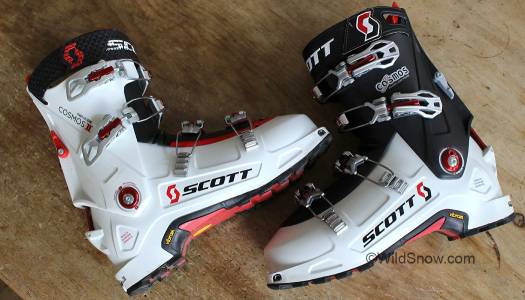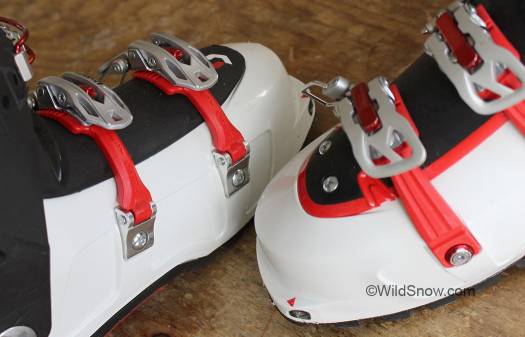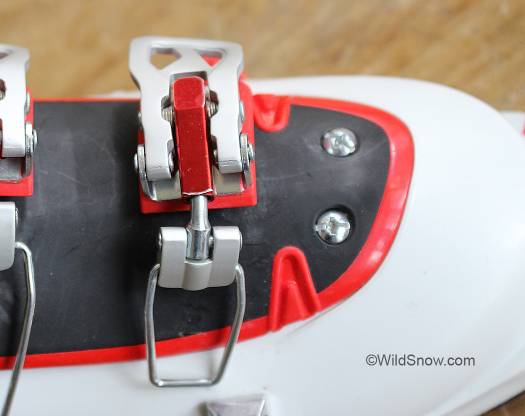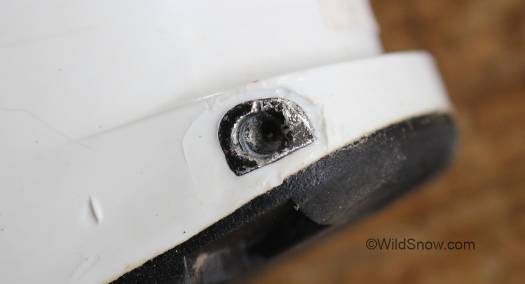Peter Anzalone
Cosmos 1 is my go-to AT boot. WildSnow handed over a pair of the new 2014/2015 Cosmos II for comparo. The boots are more similar than different (I’m happy with either), but a few changes make them worth a blog post.
(Editor’s notes: Below, for the sake of our prose we’ll standardize by writing these as “model two, model one,” or “Cosmos 2, Cosmos 1,” with a few Roman numerals thrown in for search results.)
To begin testing, I used the Cosmos II for a few inbounds uphills and ski descents on flawless corduroy and hero powder. In these conditions they performed perfectly and were thoroughly enjoyable — living up to their reputation as a precise and powerful boot. I could perceive no difference vis-à-vis the Cosmos 1.
To ramp it up, I used Cosmos II for a terrific ski tour here in our home mountains near Aspen. We did Garrett Peak and then a bonus lap on the ridge that connects Garrett to Willoughby. With this day of testing added to the mix, I’m confident I used the Cosmos 2 enough for an honest take as compared to Cosmos 1.
Comfort and Fit. Here I rate model two excellent for my plain vanilla foot. They tour nicely, with lots of articulation allowing for a long stride which was helpful when trying to keep pace with my partner, the legendary Perl. No real difference from model one, but no regression either. Model one has a tongue that’s hinged at the toe for opening, and floats forward and back a tiny bit (see photos). That can make the boot tour slightly better, but is not something I noticed.
Snow Climbing: We kicked steps up looker’s right of the big Garrett bowl and I was completely satisfied and comfortable with the sole grip as well as cuff articulation. Again, pretty much the same as model one.
Skiing: Again, a dreamy combination of comfort and control. No discernable improvement.
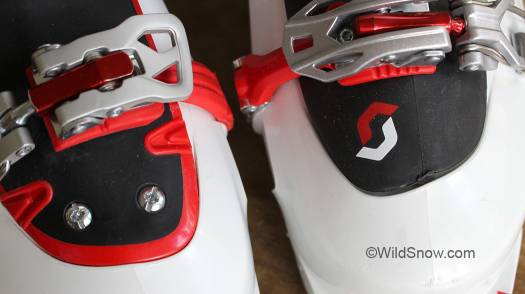
Model one to right has a hidden tongue anchor with some movement. We suspect the solid tongue anchor of the model two adds a small amount of beef in downhill mode. In real life any difference was difficult to discern.
Buckles: This might be the most significant change. Model two buckle anchor straps are obviously much beefier, and do NOT spring open like model one.
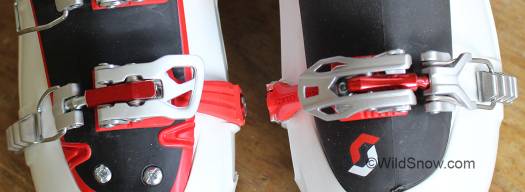
Also note the difference in buckle look. Model one to right. We’re not sure this is any more than cosmetic, but the model two buckles are perhaps slightly easier to get a finger under when opening. For some folks, the most important difference with model two buckles is that the straps are NOT spring loaded. Some skiers like that feature (I don’t mind it), while others find it inconvenient to be tripping over the buckles unless they’re secured.
Tongue Gasket. This feature is where Cosmos 2 is likely better. Feeling lazy and tired after our long slog on the snirt, I let the boot become submerged in about six inches of standing water along the exit trail. No water penetrated the boot, the liner stayed dry. This feature, for us springtime skiers, could come in handy when crossing creeks and walking through spongy low-lying terrain. What is more, a well sealed boot is appreciated when the snow gets truly slushy.
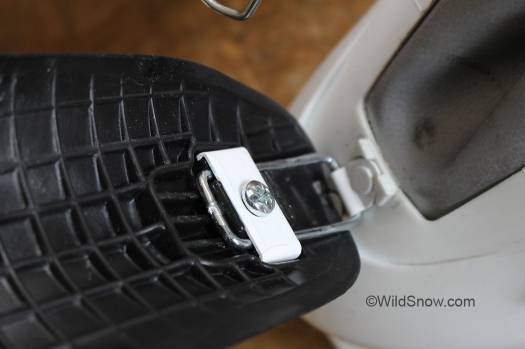
Model one has a hinged floating tongue anchor. This allows for slight movement of the tongue for and aft as well easier entry and exit, but is not as solid in downhill mode as simply screwing the tongue to the boot scaffo, as is done with model two.
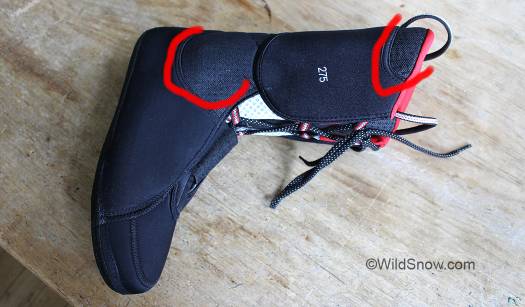
Cosmos 2 liner is similar to Cosmos 1, but has moisture breathing feature. Vent panels are circled. Optional lacing is excellent.
Liners. Model two “PWR Lite” liner looks slightly different than model one when it’s out of the boot, but as far as I could tell it fits, feels, and skis exactly the same. Both Scott liners are beautifully made and fully heat formable.

PWR LITE liner has a breathable inner skin and ventilation system that is intended to move moisture through the liner walls and out to these exterior mesh panels. It appears that Scott does this by making a series of small holes in the otherwise nonporus liner foam and letting the constant motion of your feet provide the air pump. Does it work? Time will tell.
But, and this is a BUT, Cosmos 2 liner is ostensibly made with new technology from Scott that allows your foot to breath moisture instead of being trapped in what is essentially a plastic bag, like most boot liners. The vent system is made by combining a waterproof/breathable inner layer with porous foam and areas on the outside surface of the liner that help movement of your feet “pump” moisture laden air out of the liner. I’d need to use the boots much more extensively for a take on this, but it’s an exciting idea. Swampfoot is one of the worst enemies of ski touring comfort.
(Editor’s note: This breathing feature was covered during the Scott press event we attended last winter. It sounds wonderful. We’re not sure our Cosmos 2 samples have the full retail version of the liner so we’ll withhold judgment until we’ve extensively tested what you’ll be able to get in stores. Main thing to note is if this works, it could be revolutionary for people who have problems with immersion foot types of syndromes from extensive ski boot wear.)
Weight. Our Cosmos 1 shell (no liner) sample is 1188 grams, model two is 1200. This is no more than what could be manufacturing variations, but the beefy buckle straps probably add a few grams. (Our samples are BSL 306, scaffo 27.5). With liner, weight is still nearly identical between models at 1500 grams, 52.9 ounces total for size 27.5. Very nice for a 4-buckle AT boot with DIN sole and some beef.
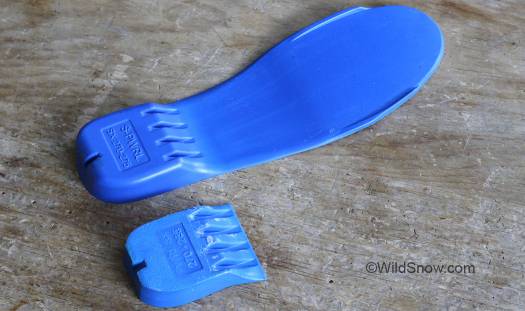
Cosmos II (top) has a full boot board inside the shell under your foot. Model one just has the heel pocket filler shown at bottom of photo. Full boot board is an important component of any boot expected to offer full performance.
Construction. Overall nearly a clone. As mentioned, different buckles and tongue. BIG DIFFERENCE is model two has a boot board inside the shell that allows for a bit more fit customization and perhaps adds some warmth. I’m thinking they might make this model with a bit less thickness in the shell plastic under the foot, to allow room for the boot board, as I could feel rocks deforming the boot under my feet while hiking. I’m not used to that feeling, Lou tells me it’s normal for modern boots that are relatively lightweight.
Overall. Cosmos model two appears slightly better made than model one (note, I’ve had no problems whatsoever with model one). As I said before, this is a very nice ski boot and if it fits your foot, I think it will perform extremely well both up and, most importantly, down. Important thing to know is either model will work.
Please see our extensive coverage of Scott Cosmos.
Shop for Scott Cosmos ski touring boots.
(WildSnow guest blogger Pete Anzalone lives in Snowmass Village, Colorado with his wife Angeles and son Paul. When not skiing uphill, downhill or sideways, Pete can be found running PubWorks, a software firm specializing in work order and asset management products for city and county government.)
Beyond our regular guest bloggers who have their own profiles, some of our one-timers end up being categorized under this generic profile. Once they do a few posts, we build a category. In any case, we sure appreciate ALL the WildSnow guest bloggers!

